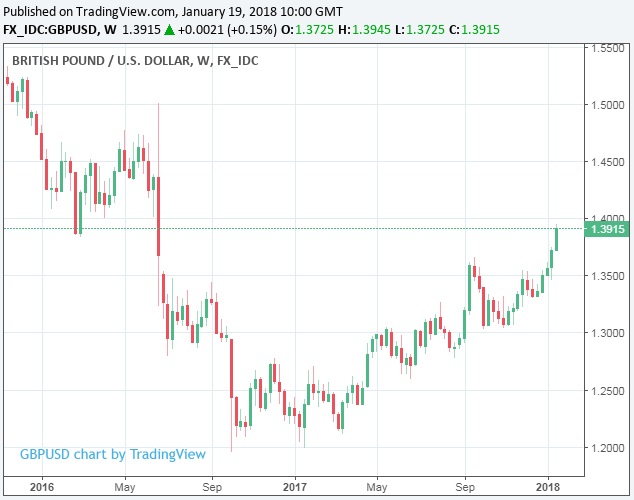Pound Sterling Clings to 'Best Performer' Crown Despite Sharp Fall in UK Retail Sales
- Written by: James Skinner

The British Pound is still the best performing G10 currency this week after shrugging off some dire news from the UK retail sector.
The Pound appeared to shrug off a steeper-than-expected fall in UK retail sales in the month of December, the details of which were released on Friday, January 19.
The resillience suggests there may be scope for the British currency to cling to its best-performer crown as the week draws to a close.
Office for National Statistics data showed UK retail spending fell by 1.5% during December, a steeper reduction than the 0.8% decline expected by economists, while fourth-quarter growth came in at a measly 0.4%.
Economists had predicted retail sales would grow by 0.8% for the final three months of the year, which would have been in line with the expansion seen in the third quarter.
The annual pace of growth in high street spending, at 1.9%, was the slowest since 2013.
Consumers, after all, faced a steep rise in inflation during 2017 that put pressure on real incomes and spending.
"A fall in retail sales volumes in December had always looked likely, given November’s hefty rise," says Ruth Gregory, a UK economist at Capital Economics. "After all, UK retailers’ adoption of “Black Friday” discounting appears to have caused consumers to bring forward their Christmas purchases, rather than to buy more overall in recent years."
December's data followed surprisingly strong growth of 1.1% in November although this expansion now looks to have been more than reversed.
Friday's report came closely on the heels of dire news for home furnishings retailer, Carpetright, which saw its shares crash by nearly half after posting a surprise profit warning confirming the UK high street finds itself in a precarious position.
"Despite a positive start to our third quarter, we have seen a significant deterioration in UK trading during the important post-Christmas trading period," Wilf Walsh, chief executive at Carpetright, announced Friday.
"While average transaction values were up year on year, the number of customer transactions since Christmas was sharply down, which we believe is indicative of reduced consumer confidence."
The impact on Sterling of the headlines was ultimately muted however.
"A disappointing set of retail sales figures out of the UK has done little to dent the ascendancy of the Pound, amid a week of upside for sterling. However, today’s figures should be taken with a pinch of salt, with the deterioration in December retail sales coming amid a shift in shopping trends, towards the black Friday/cyber Monday fuelled November rather than last minute pre-Christmas spending in December," says Joshua Mahony at IG.
The Pound was quoted 0.22% higher at 1.3920 against the US Dollar after the release Friday, broadly unchanged from before the retail sales data were announced, which is its highest level since the referendum of 2016. The Pound-to-Euro rate was seen 0.20% lower at 1.1338.

Above: Pound-to-Dollar rate shown at weekly intervals.
Advertisement
Get up to 5% more foreign exchange by using a specialist provider to get closer to the real market rate and avoid the gaping spreads charged by your bank when providing currency. Learn more here.
How Much Higher Can the Pound Go?
Sterling looks to end the week on a high against the Dolar, while holding onto ground above 1.13 against the Euro.
“The pound is touching distance away from our long-held conviction call of 1.40 against the US dollar in 1Q18 – but even we're slightly surprised by the speed at which we have got there,” says Viraj Patel, a strategist at ING Group.
Sterling has performed strongly so far into January following further signs that that the Brexit saga will ultimately conclude amicably.
“Sure, most of it has to do with extensive $ weakness – which has evolved pretty much in line with our thinking. But one can also detect a subtle shift in the directional sentiment for GBP – not least as the doomsday Brexit tail risks gradually fade (for good reasons, they will never fully disappear),” Patel adds.
In addition, European lawmakers have also been said to be considering watering down efforts to force financial clearing houses to decamp from London after Brexit.
This has been seen as augering a more conciliatory approach to Brexit talks between the two sides, as well as increased hopes of a so called “soft Brexit” or a BINO (Brexit in Name Only).
“We do think there is more upside for GBP yet to come in 2018 – but for now, we will require a positive GBP-related catalyst to take us over the 1.40 line. Here we continue to cite 2 non-mutually exclusive potential sources: (1) positive UK data surprises and (2) actual Brexit progress in the form of an agreed transition deal,” Patel writes, in his morning briefing.
January’s Brexit developments come after the European Council voted in December to allow Brussels’ negotiators to begin discussing the future relationship.
Talks will renew later this month, with markets looking to see an agreement over a transitional period struck before discussions move onto trade in March.
Faster Growth and a Restless Bank of England
With Brexit aside, Friday’s data marks the final verdict on UK consumer spending in 2017 and comes at a time when the economy has been seen regaining some of its lost momentum.
“While resilience in the UK consumer is important – it is the investment side of the economy that has the greater scope to positively surprise to the upside in 2018 (via the theoretical lens of reduced uncertainty). We look for GBP/USD to consolidate within the 1.3850-1.3900 area – with outside risks of 1.40 today,” says Patel.
GDP growth slowed sharply to 0.3% over the first half of 2017 as rising inflation eroded the value of “real GDP”, although growth picked up to 0.4% in the third quarter while many say the economy either held this latter pace, or improved upon it in the fourth quarter of the year.
Most economists forecast UK GDP growth of around 1.8% for 2017. This would be down from the 1.9% growth seen in 2016.
What happens in 2018 remains an open question. Many economists expect that UK inflation, which reached 3.1% in November and crimped growth persistently throughout 2017, will recede throughout 2018. Indeed, the UK consumer price index already fell by 10 basis points in December, down to 3%.
“The fall-back in CPI inflation from 3.1% in November to 3% in December probably marks the beginning of what we expect will be a sustained downward trend over the course of 2018,” says Paul Hollingsworth, a senior UK economist at Capital Economics.
If inflation falls back even further then it could ease some of the pressure on real GDP growth over the course of the year.
“Despite this, we still think that the Monetary Policy Committee (MPC) will raise rates several more times this year,” adds Hollingsworth.
The Bank of England helped to boost Sterling late last year when it raised interest rates, for the first time in a decade, by 25 basis points to 0.50%. Opinions have been divided over when it might raise rates again.
There are grounds to think that falling inflation would be enough to ensure the BoE stands pat for the time being. However, if lower inflation results in faster GDP growth and comes at the same time as wage growth is picking up, rate setters might not be so patient.
Any sign that another increase in interest rates could be on the horizon would be very positive for the Pound Sterling.
Advertisement
Get up to 5% more foreign exchange by using a specialist provider to get closer to the real market rate and avoid the gaping spreads charged by your bank when providing currency. Learn more here.




